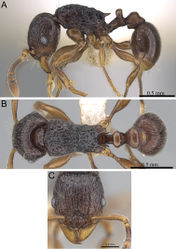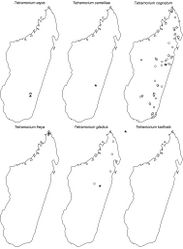Tetramorium camelliae
| Notice: | This page is derived from the original publication listed below, whose author(s) should always be credited. Further contributors may edit and improve the content of this page and, consequently, need to be credited as well (see page history). Any assessment of factual correctness requires a careful review of the original article as well as of subsequent contributions.
If you are uncertain whether your planned contribution is correct or not, we suggest that you use the associated discussion page instead of editing the page directly. This page should be cited as follows (rationale):
Citation formats to copy and paste
BibTeX: @article{Hita2014ZooKeys413, RIS/ Endnote: TY - JOUR Wikipedia/ Citizendium: <ref name="Hita2014ZooKeys413">{{Citation See also the citation download page at the journal. |
Ordo: Hymenoptera
Familia: Formicidae
Genus: Tetramorium
Name
Tetramorium camelliae Hita Garcia & Fisher sp. n. – Wikispecies link – ZooBank link – Pensoft Profile
Type material
Holotype, pinned worker, MADAGASCAR, Fianarantsoa, Ranomafana National Park, Vohiparara, 21.24444°S, 47.39694°E, 1173 m, montane forest, 16.IX.1992 (E. Rajeriarison) (CAS: CASENT0247496). Paratypes, four pinned workers with same data as holotype (BMNH: CASENT0247495; CAS: CASENT0247499; MCZ: CASENT0247498, CASENT0247500).
Non-type material
MADAGASCAR: Fianarantsoa, Ranomafana National Park, Vohiparara, 21.24444°S, 47.39694°E, 1173 m, montane forest, 16.IX.1992 (E. Rajeriarison); Fianarantsoa, Ranomafana National Park, Vatoharanana River, 4.1 km 231° SW Ranomafana, 21.29°S, 47.43333°E, 1100 m, montane rainforest, 27.–31.III.2003 (B.L. Fisher et al.).
Diagnosis
The strongly squamiform and transverse petiolar node, which in profile is around 2.7 to 3.0 times higher than long (LPeI 33–36), and in dorsal view around 2.3 to 2.4 times wider than long (DPeI 228–238), isolates Tetramorium camelliae from the other members of the Tetramorium cognatum species complex.
Worker measurements
(N=7). HL 0.56–0.63 (0.61); HW 0.50–0.57 (0.55); SL 0.33–0.40 (0.38); EL 0.13–0.15 (0.14); PH 0.25–0.29 (0.27); PW 0.40–0.44 (0.43); WL 0.67–0.78 (0.74); PSL 0.10–0.12 (0.10); PTL 0.07–0.09 (0.08); PTH 0.21–0.25 (0.24); PTW 0.16–0.21 (0.19); PPL 0.15–0.20 (0.18); PPH 0.21–0.25 (0.24); PPW 0.20–0.26 (0.24); CI 89–91 (91); SI 66–70 (68); OI 25–26 (26); DMI 56–60 (57); LMI 36–37 (37); PSLI 17–19 (18); PeNI 40–48 (45); LPeI 33–36 (35); DPeI 228–238 (234); PpNI 50–59 (57); LPpI 69–80 (74); DPpI 133–141 (137); PPI 120–134 (126).
Worker description
Head much longer than wide (CI 89–91); in full-face view posterior head margin weakly concave. Anterior clypeal margin with distinct median impression. Frontal carinae moderately developed, diverging posteriorly, merging with surrounding sculpture halfway between posterior eye margin and posterior head margin. Antennal scrobes weak, shallow and without clear and distinct posterior and ventral margins. Antennal scapes very short, not reaching posterior head margin (SI 66–70). Eyes relatively large (OI 25–26). Mesosomal outline in profile flat to weakly convex, comparatively low and long (LMI 36–37), moderately marginate from lateral to dorsal mesosoma; promesonotal suture absent; metanotal groove present, but weakly developed. Propodeal spines short, triangular to elongate-triangular, and acute (PSLI 17–19), propodeal lobes triangular to elongate-triangular and of approximately same length as propodeal spines, in profile spines and lobes strongly inclined towards each other. Petiolar node in profile strongly squamiform, around 2.7 to 3.0 times higher than long (LPeI 33–36), anterior and posterior faces approximately parallel, anterodorsal and posterodorsal margins situated at about same height, petiolar dorsum relatively flat to weakly convex; node in dorsal view transverse and 2.3 to 2.4 times wider than long (DPeI 228–238), in dorsal view pronotum between 2.1 to 2.5 times wider than petiolar node (PeNI 40–48). Postpetiole in profile subglobular, between 1.2 to 1.4 times higher than long (LPpI 69–80); in dorsal view around 1.3 to 1.4 times wider than long (DPpI 133–141), pronotum between 1.7 to 2.0 times wider than postpetiole (PpNI 50–59). Postpetiole in profile much more voluminous than petiolar node, postpetiole in dorsal view around 1.2 to 1.4 times wider than petiolar node (PPI 120–134). Mandibles completely unsculptured, smooth, and shiny; clypeus irregularly longitudinally rugulose, median ruga never fully developed, usually reduced to few traces posteriorly or medially, one or two mostly unbroken lateral rugulae present on each side; cephalic dorsum between frontal carinae longitudinally rugose/rugulose with seven to eight rugae/rugulae, rugae usually running unbroken from posterior clypeal margin to posterior head margin, sometimes interrupted or with cross-meshes; scrobal area partly unsculptured, but mostly merging with surrounding reticulate-rugose to longitudinally rugose sculpture present on lateral head. Dorsum and sides of mesosoma longitudinally rugose/rugulose. Forecoxae unsculptured, smooth and shining. Ground sculpture on head and mesosoma weak to absent. Both waist segments and gaster fully unsculptured, smooth, and shining. Dorsum of head with several pairs of long, fine, standing hairs; mesosoma with seven to eight pairs restricted to pronotum and mesonotum; propodeum, waist segments and first gastral tergite without any standing hairs; first gastral tergite with short, moderately dense, appressed pubescence. Anterior edges of antennal scapes and dorsal (outer) surfaces of hind tibiae with appressed hairs. Head, mesosoma, waist segments, and gaster uniform brown to dark brown, appendages yellowish to light brown.
Etymology
The new species is dedicated to the first author’s lovely life partner, Tracy Lynn Camellia Audisio from San Francisco, California, U.S.A.
Distribution and biology
Tetramorium camelliae is a rare species only known from Ranomafana National Park (Fig. 63) where it was collected twice in montane rainforest at elevations ranging from 1100 to 1173. The little available data indicates that Tetramorium camelliae lives in leaf litter.
Discussion
Tetramorium camelliae is easily distinguishable from the other members of the Tetramorium cognatum species complex. The main diagnostic character is the petiolar node shape, which is strongly squamiform in Tetramorium camelliae (LPeI 33–36; DPeI 228–238) but not in the remainder of the species complex (LPeI 37–62; DPeI 111–171). Generally, its smaller body size, weaker frontal carinae, and gastral pubescence ally Tetramorium camelliae morphologically with Tetramorium aspis, Tetramorium cognatum, Tetramorium karthala and Tetramorium rumo.
Original Description
- Hita Garcia, F; Fisher, B; 2014: The hyper-diverse ant genus Tetramorium Mayr (Hymenoptera, Formicidae) in the Malagasy region taxonomic revision of the T. naganum, T. plesiarum, T. schaufussii, and T. severini species groups ZooKeys, 413: 1-170. doi
Images
|


